- Industries & Machines Industries & Machines
- IIoT IIoT
- Service-Toll Processing Service-Toll Processing
- Material Material
- News News
- IR Information IR Information
-
Sustainability
Sustainability
Sustainability
- Introduction
- Sustaibality Policy - Mission Statement
- Editorial Policy
- Materiality & Strategy
- Technological contribution to a sustainable global environment
- Contributions towards a safer, more secure and prosperous society
- Sophistication of governance that supports business
- ESG Data Collection
- Sustainable Business Management ~ Finance
- Infromation Disclosure Based on TCFD Recommendations
- Jobs and Careers Jobs and Careers
-
About Us
About Us
About Us
- Corporate Vision
- Greetings (Company Introduction)
- Corporate Overview
- Corporate Profile
- Business Areas and Strengths
- Corporate History
- Hosokawa Micron Group
- Domestic Facilities
- Overseas Subsidiaries (Asia)
- Overseas Subsidiaries (Europe)
- Overseas Subsidiaries (America)
- Asian Agents
- Powder Technology Research Institute
- Industrial Property Rights
- Journals and Books
- Technical Information
- Annual Publication "Micromeritics"
- Compliance Charter
- Privacy Policy
- Cookie Policy
- Quality Principle

Industries & Machines
- TOP
- Industries & Machines
- Machines Search
- Pulsjet Collector, Standard Type SP
Pulsjet Collector, Standard Type SP
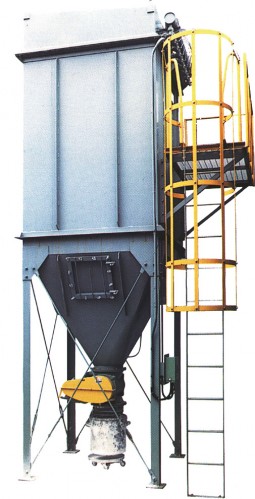
Summary
The Hosokawa/Micron Pulsjet Collector is a dry dust collector, collecting powder from dust -laden air through filter media by intermittent, momentary, pulsejet cleaning, energized by compressed air. The Pulsjet Collector is widely used in dust collection with the use of low -pressure blower, or as an air relief filter of low-pressure design. Filtered powder is blown-off by introduction of short, sharp blasts of high-pressure air/gas (pulsejet) from inside of the filter bags. Because blow-off time for each row of filter bags is quite short, it does not affect total filter operation. Pressure drop across all filters is kept uniform, thus does not affect process airflow and pressure. The standard type uses a square housing and filters are arranged efficiently inside.
Principle
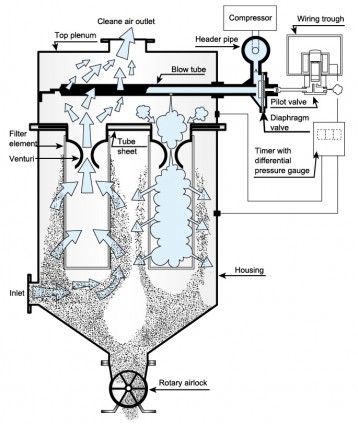
Fig.1 Principle of Pulsjet collector
Consists of a filter part, which collects powder, a blow-off part where pulsejet compressed air is stored and jetted, and a housing that holds these parts and a timer which controls pulse-jet action. Blown-off powder is continuously discharged.
Filter
A dust laden gas flow through the filter from outside to inside and the powder is collected at the outer surface of the filter. Gas passing through the filter becomes the “cleaned” gas and the collected powder is discharged to outside though the discharge outlet. Usually cylindrical felt fabric filter is used, however, space saving type, pleated elements (K type) has a larger filter area per unit and can be utilized well. In case of felt filters, metal retainers are inserted inside to hold the cylindrical shape. Filter material is selected depending on the type of powder, gas temperature, and gas composition.
Blow-off mechanism
Consists of a header pipe where compressed air is stored, diaphragm valves which blow-off the air in the header pipe in very short time, pilot solenoid valve which exhaust a little amount of air to activate the diaphragm valves and blow tubes through which compressed air is discharged to the filters. Suitable cleaning cycle specification is decided depending on total filter area and the pressure of the compressed air.
Housing
A top plenum which holds the blow-off part, a tube sheet which holds filters and separates clean and dirty sides, a straight body part which contains the filters, and a hopper part where powder is collected and conveyed to a discharge. Material is selected depending on the application of the powder, gas temperature and gas composition. Usually general purpose rolled steel (SS400) or stainless steel is used as construction material.
Timer
It contains the circuit board, which controls the pilot solenoid valves and sets the on/off time. Options can be selected such as display of pressure drop across the filter, differential pressure control mechanism, which activates pulse-jet when the pressure drop reaches the predetermined pressure, or differential pressure signal transmitter.
Discharging
During operation there is a differential pressure between inside and outside of the bag filter, the internal collected powder should be discharged while correctly air-locked. A rotary valve is a typical discharge device, it has a revolving rotor, which has discharge pockets. By minimizing the clearance between the rotor and the casing gas flow leakage is minimized.
Features

Fig.2 Pulsjet Collector SP-49-4K
Depending on requirement many models are available with various filter areas, shapes, and filter replacement methods.
SP Type
Small bag filters with filter area up to 108m2. These units can be shipped completely assembled. Filter replacement is done from the side (side removal type). This type is suitable for use when there is height limitation.
SP type is available for the filtering area of 8.0m2-108m2.
SP-K Type
A cartridge filter, which has larger filter area per unit, is mounted in the SP type square housing. Maximum filter area is 250m2. Large filter area is available with small installation space.
SP-K type is available for the filtering area of 8.6m2-250m2.
Applications
- Nuisance venting
- Exhaust gas from incinerators
- Exhaust gas from boilers
- Venting from entire sheds
- Oxygen production plant
- Exhaust gas from zinc plating work shop
- Exhaust gas from metal melting pot
- Exhaust gas Powder painting booth
- Exhaust gas from diesel electric generation
- Product collection from pulverizers
- Product collection from classifiers
- Product collection from dryers
Specifications
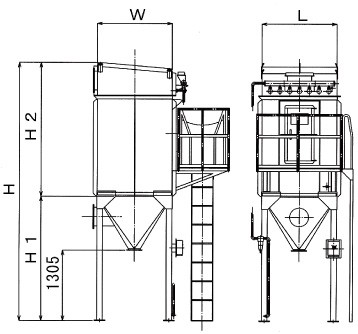
Fig.3 Dimensions of SP
Other information
Option
Pleated Filter
Pleated filter stocking has more than twice filtering area than the ordinary felt filter. This makes smaller installation space than conventional bag-house. Easier mounting of filters in bag-house than the conventional technology.
Discharge
RV-20K
A rotary valve driven by motor with reduction gear. Required power is small compared to the capacity. Assembling and disassembling is easy. Rotor capacity is 7 liter/rev.
RV-20IND, RV-30IND
A rotary valve driven via. chain by motor with reduction gear. Two models are available, RV-20IND with 7liter/rev. rotor and RV-30IND with 28liter/rev. rotor.
HUV type discharger
The HUV Type (Horizontal Unloading Valve) discharger is mounted at the bottom of the bag filter. It scrapes off the powder accumulated on the bottom of the bag filter by vanes and sends it to the discharge outlet. Usually a rotary valve is used to ensure an air-lock is maintained. It is used for materials, which tend to form bridges or in the case where there is height limitation.
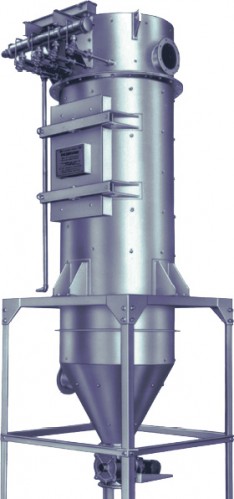
Fig.4 RV is connected to Pulsjet collector CP

Fig.5 Pleated filter
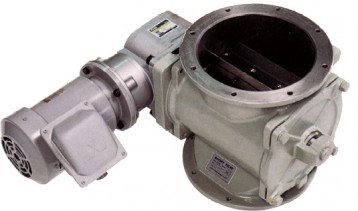
Fig.6 Rotary airlock RV-20K

Fig.7 Discharger HUV-12
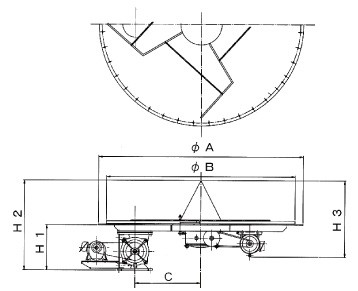
Fig.8 Dimensions of HUV

Feel free to contact us. if you have any questions or concerns.

